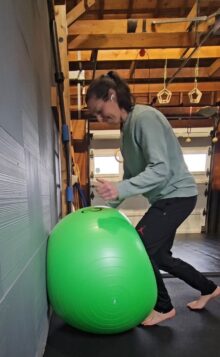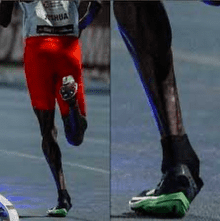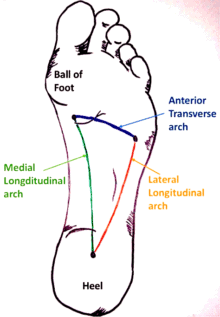Alternative Title: Describing the Avoidant Half I have been writing about asymmetries for some time. Whether it be determining the up leg from from down leg, or the pitfalls of detorsioning the system, I continue to find and… Read more ›
The first post in this series asked if a pigeon toe was friend or foe. It is certainly a strategy, an adaptation that has a purpose. For me, my half with the pigeon toe also carried my biggest problems, particularly… Read more ›
Part 1 of this series explained how knee should not be used as a load-bearing joint. Part 2 showed how pressuring the knee can help build safety, alignment, and desired force at the desired time. This third and final segment… Read more ›
In part 1, I suggested that using the knee as gas instead of brakes could help free up the knee for motion and elicit the hips and ankle-foot as stabilizers. For folks with chronic pain, however, their nervous system likely… Read more ›
There are three hinges on the feature photo door. It’s a strong front door, solid and meant to take some battering. The cheaper, lighter, all-have-problems-closing-and-opening doors inside the house have only two hinges. Weight-load divided by two, or weight-load divided… Read more ›
Torsion. We all have it: a particular line of twist running through our carriage, gripping us in a certain way and keeping us upright. Each fold and joint tells its story, whether you realize it or not. It’s how we… Read more ›
At its core, this get together was a homage to Adarian Barr. It was about curious and capable mortals grasping at genius, and that genius laying out his latest findings and figurings in a simple yet thorough process of feeling and… Read more ›
While walking through the streets of Europe last Spring, Adarian Barr wondered why his feet felt so good. He traced it back to the cobblestones. The lift, the variability, the multiple points of potential folding. This was the impetus behind… Read more ›
When new words are introduced, we tend to react as if they make things more complicated. We already know. We already have an understanding on what the terms we already use mean. Why would we change? We change when we are… Read more ›
Pairs. Roles. Asymmetry. The body knows and the body has ways. Understanding the differences between the halves helps you appreciate them. One side isn’t ‘good’. The other isn’t ‘bad’. They hold a function within the system. Here’s a big picture… Read more ›
My left leg has some problems. I could fill in the whys with any number of stories — the many ankle sprains during my athletic career, the torn and hamstring-repaired ACL, the pigeon toe I gave myself because of a… Read more ›
This post serves as a follow up to: A Path Towards Harm. Otherwise titled: The things I did wrong when I didn’t pay attention or have compassionate patience. The tag to this blog used to read, “fix yourself.” But… Read more ›
Everything I know about the transverse arch, I owe to Adarian Barr. The following is my attempt to take his words and concepts and relate them to my own body and understanding. It is, in effect, my translation. The layers… Read more ›
The low gait might be the truest test of healthy knees. It requires full flexion under full bodyweight while pulling the center of mass. A single knee is responsible for stabilizing load while the feet and ankles pivot and reposition.… Read more ›
Joint ‘popping’ is a curious thing. It alarms without hurting. Especially when you realize it wasn’t there before. You notice something is different when you do that particular thing in that particular way. The different becomes ‘less than’ when… Read more ›
This post serves as a companion piece to Pain Exploration: Medial Knee. It picks up right where it left off, with manipulations of the ankle, foot, and toes. A low sit with the heel up and toes extended (an expression… Read more ›
For about two months, I’ve had some chronic discomfort in my left knee. On a scale of 1-10, with ’10’ being agony and ‘1’ being noticeable/annoying, it oscillates between 1 and 4. Though this might be thought of as acceptable… Read more ›
The tip toes position is an assessment of toes, feet, and ankle control. Balance comes from joint stacking. The push off when we walk comes from a high heel. A toe point or push is required with reaching. Loaded plantar… Read more ›
If you’re stuck in a movement plateau, changing the direction in which you impart force into a joint will often translate into greater mobility. The body reacts in function what is demanded of it by stress. Andreo Spina describes this… Read more ›
The more I work with folks to teach proper foot function, the more I am drawn to the toes. Arching, gripping, and pushing are toe driven movements. The toes feel and sense the ground, giving it’s feedback to the feet… Read more ›
The source of this information is three months or roughly 100 hours of an art school Physical Education class. It is an evolving process of getting 40 kids first period to prep their ankles and feet for movement and game… Read more ›
Plantar fasciitis is an inflammation of the ligaments and/or muscles on the bottom of the feet. It is typically caused by ‘overuse’… in a repetitive, dysfunctional pattern. photo credit : braceability.com It is a common injury in runners or people… Read more ›






















